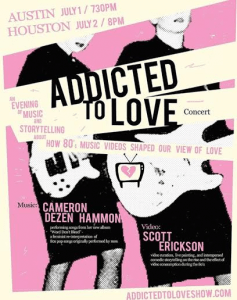

Unless I somehow got my hands on a DeLorean and then decided to go back to the 80’s, I don’t think that I ever would be able to appreciate the iconic music that came out of the decade if it weren’t for Cameron Dezen Hammon’s album, Words Don’t Bleed and her Addicted to Love concert series.
Picture a small crowd of maybe 20 or 30 people, one piano, one guitar, a blank canvas, and muted 80’s music videos playing in the background. Now add Cameron Dezen Hammon sitting behind that piano, casually chatting with the crowd, reminiscing about her adolescent years of the 80’s while her husband, Matt Hammon, accompanies her on the guitar, and Scott Erickson paints a scene of starry night encapsulating a single house, pausing every once in awhile to tell the crowd about some of his favorite music videos of the decade. It was a night of intimate conversation, laughter, and beautiful art, but also of eerie realizations and thought-provoking analysis.
Dezen Hammon’s album, Words Don’t Bleed covers songs from the 80’s that were originally performed by men, often changing the chords from major to minor, eliminating the mainstream upbeat pop feel and replacing it with a much more personal and emotional vibe that forces the listener to focus on the heart-rending, tragic, and unfortunately sexist lyrics that have reinforced and built up the strength of the patriarchy for almost 40 years now. The first song on her album, “Father Figure†originally sung by George Michael, grasped me with its downcast, but catchy melody, then caught me off guard with lyrics are about a man pursuing a woman by telling her that he “will be [her] father figure†and her “preacher, teacher.†I couldn’t help to feel uncomfortable, especially with the original music video playing behind Dezen Hammon’s live performance, in which George Michael essentially stalks a girl (who seems to be doing way better in life than he is), broods in the shadows, smoking a cigarette, waiting for his female prey to come running to her manly savior. Dezen Hammon commented that she knew something was wrong with this song from a young age, and I understand why. I mean, I would think that the last thing you would want to think about before hooking up with a guy would be your dad, but George Michael got away with expressing conformity to the savior complex of a man leading a woman, of a father leading his daughter into the bedroom? Ugh, what a creep. Dezen Hammon’s version helps to bring out the flaws in George Michael’s version. The lyrics are uncovered from their original happy pop-rock chord veil. Hearing a woman make these words her own, not only brings out the vulnerable side to a lover pouring out their deep desires, but also a reminder that nothing is wrong with women being blunt with their feelings and initiating relationships. Honestly, I don’t know why Dezen Hammon doesn’t just drop her mic and walk out every time she finishes this song because if it were a competition, she would beat George Michael every time.

The 80’s music videos playing behind Dezen Hammon’s live performance significantly increased the power of her covers, especially during her cover of Robert Palmer’s “Addicted to Love.†Compared to Palmer’s version, Dezen Hammon’s is much more dramatic and focused on the tragedy of losing one’s self control to the power of love. Palmer’s original music video consists of lifeless pale-faced tall identical robotic women wearing matching black translucent dresses, staring at nothing in particular in the distance while awkwardly swaying and pretending to play instruments. After the song was over, there was talk of Palmer having to get the women in his music video drunk so they would not be so rigid while they danced. Talk about idolizing unachievable beauty standards and objectifying women so that they will come off as more “appealingâ€â€¦ Instead of celebrating these specific women and their “addiction†to love, Dezen Hammon removes the easy-going rock’n’roll vibe and replaces it with an emotional tribute to the loss of humanization. With lyrics such as “you can’t be saved†and “your will is not your own,†an upbeat happy tune just doesn’t seem to fit. Palmer’s portrayal of these “perfect†women helped to set the impossible beauty standards of today’s society. Dezen Hammon commented on the importance of diversity and how having identical robotic women with no “flaws†is not what we need in our society. It is impossible to be perfect. We are humans; we have flaws. That’s what makes us vulnerable enough to love. Also, who really finds robots sexy anyway?
One of my favorite parts of the performance was when Scott Erickson, the painter and storyteller, shared Bon Jovi’s “Wanted Dead or Alive†music video. Erickson talked us through everything that was happening from his own perspective. There were a lot of shots of the overworked rock star and his difficult life of having to deal with so many fans, cool backstage stretches, sweaty long hair, and snazzy leopard print pants. It was fun to joke around about the 80’s rock star life, but Erickson made several intriguing points about Bon Jovi and how this music video is a great representation of how we live our lives today. Erickson freeze-framed on a shot of Bon Jovi pointing the mic towards the crowd at one of his concerts with the house lights up. The focus of the shot is on all of the fans, fawning and screaming over Bon Jovi, you know, the fans who want him “dead or alive.†Erickson talked about how we tend to present ourselves in ways that are most likely to get people to like us. We need the approval of others and we seek it through the use of social media. We want people to love us the way that those fans loved Bon Jovi. We have easy access to platforms upon which we can make our voices and opinions heard, a place where we can present a version of ourselves that is aesthetically pleasing to the rest of the world even it doesn’t actually represent our true selves. Erickson also commented on how one of the ways that we create this image that we wish to be put on a pedestal is by re-sharing a recycling old ideas. It seems like there is less and less original content on social media every day. There are more and more articles and pictures being re-posted than ever. This is not necessarily a bad thing, but we also need to remember the importance of creating art, the value of being able to get in touch with our inner selves and express that without the fear of having to impress someone else. Dezen Hammon used this moment to comment “and that’s why I made an 80’s cover album,†receiving a giggle from the audience. So to re-explain things, yes, copying and pasting something does not create anything new, but taking something that you already know, adding your own twist, and giving it new meaning is an art form.
Cameron Dezen Hammon has given her own meaning to these 80’s tunes, breaking down male domination and turning it into female empowerment, not to mention the music itself is beautiful and incredibly well performed. I’ll probably continue to picture a blur of colorful tracksuits, frizzy poofed up hair, and John Hughes movies when I think of the 80’s, but I’m glad that I got to learn about the still relevant music of the era and its impact on today’s society. Be sure to check out Words Don’t Bleed and perhaps an upcoming music video of “Maneater†in which Dezen Hammon appears as a zombie? We’ll just have to wait and see! I might as well face it; I am addicted to this album.
Photo Credit: Addicted to Love artwork: Scott Erickson
By Emily Macune
